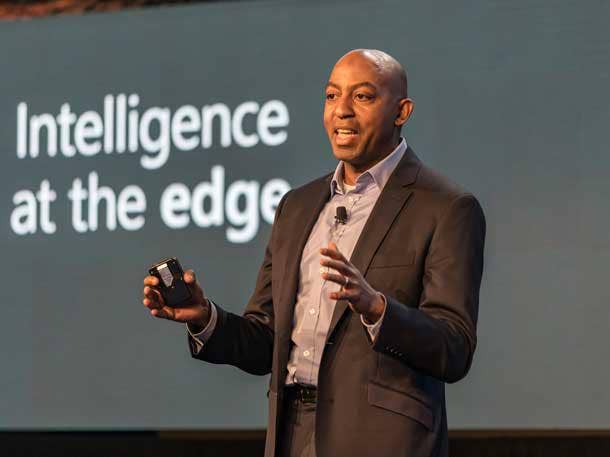What Microsoft VP Rodney Clark Learned From 1,000 IoT Deployments
In an interview with CRN, Microsoft executive Rodney Clark talks about the biggest lessons his team has learned from more than 1,000 Internet of Things deployments the company has worked on, ranging in topic from new business models to security.

Helping Partners Build Scalable Solutions
For the past several years, Rodney Clark has had a front-row seat at Microsoft to the way companies have been adopting Internet of Things solutions and what makes deployments actually work.
As the vice president of IoT and mixed reality sales at Microsoft, Clark said it recently occurred to him that while there has been a lot of discussions around the IoT market in general, there isn't enough talk about the real work that leads to successful projects. That prompted him to create an outline of the biggest lessons he's taken from more than 1,000 IoT deployments Microsoft has been involved with.
"For me, this conversation started with saying, 'What's actually happening, what are partners and customers actually going through, and how do we articulate this to the next partner, so that they don’t have to go through all of these things,'" Clark told CRN, speaking of the challenges associated with IoT.
Clark said he works with an ecosystem of more than 8,000 partners — ranging from system integrators to OEMs and software vendors — and helps them build devices, as well as edge and cloud solutions that include predictive maintenance and artificial intelligence applications, among other types of solutions.
Over the past few years, Clark said his role has transitioned from one that was focused on selling products to customers to one that is more collaborative and hands-on in nature.
"My role has changed from purely transactional to how we can help partners build a scalable solution and enable their profitability and success," he said.
What follows are some of Clark's top lessons from IoT deployments.

Business Starts When The Customer Buys A Product
It used to be that when a business sold a product to a customer, that would mark the end of the transaction, but just in the way Software-as-a-Service has changed that thinking in the software world, things have also changed in the real world thanks to IoT.
"One lesson for me was this notion that business starts when the customer buys a product," Clark said.
Clark cited a small bakery business Microsoft has worked with as an example. In the past, the bakery had purchased security cameras from one company and meat slicers from another. But as the bakery sought new ways to improve engagement with its own customers and increase the efficiency of its operations — making sure there were croissants, for example, on any given day — the bakery's relationship with these two vendors changed from one-off transactions to a services model approach.
In the case of the security camera provider, the vendor began offering an advanced camera with an embedded processor that could use artificial intelligence to capture the demographics and foot traffic of customers. The meat slicer company, on the other hand, eventually went into the business of selling sensors and software for helping businesses keep on track of food inventory and safety.
For the bakery, these two innovations gave it a better understanding of its clientele and its daily production flow, which enabled the bakery to fine-tune its marketing and adjust its daily production schedule based on trends for customer traffic, popular products and weather. Like the bakery's relationship with the two vendors, its connection with customers became more ongoing because of the bakery's ability to hone in on their preferences and behaviors.
"What this is helping a small business do is in essence forecast sales and create an experience for each customer walking into the store," Clark said.

Business Model Transformation Is Necessary
The idea of business starting when a customer buys a product ties into another takeaway Clark had from his observations of IoT deployments: business model transformation is necessary.
Continuing with the bakery example, Clark said the bakery and its two vendors all transformed their business models. In the case of the security camera vendor, the company now has stream of recurring revenue thanks to its ability to provide cloud analysis software that breaks down the demographics of customers and their foot traffic, which in turn, creates new value for the bakery.
The same can be said for the meat slicer vendor that now provides cloud software for monitoring the inventory and temperature of baked goods.
"Now they're actually enriching their ability to drive revenue because they're setting an analytic capability," Clark said. "They can charge for that service and profit more over the long term."
Sometimes this transformation can be achieved by a company acquiring a business that has capabilities it would like to provide, such as cloud software, Clark said. Other times, the company can decide to invest in building their own internal capabilities.
When it comes to business model transformation related to IoT and other new technologies, Clark said traditional technology leadership roles, such as the chief information officer, need to be reexamined because their role no longer concerns the technology — it requires an understanding of how they interact with the different lines of business under new business models.
"That's where you have this notion of the chief digital officer and chief transformation officer," he said.

The Technology Must Solve A Real Problem
This brings another important point: the technology must solve a real problem, Clark said. It's not enough to just give something an internet connection and hope that it provides something of value. The companies working on an implementation must start with the problems faced by the customer and then determine how the technology can solve it or improve a situation.
In another example, Clark cited a smart city project that sought to improve public transportation in a few specific ways: to help people get to where they're going faster and to reduce traffic congestion at multiple intersections — two interconnected goals — while also providing them free Wi-Fi.
This required implementing and synthesizing multiple systems. First, the card reader system inside the bus to count the number of people coming onto a bus, complemented by a bi-directional sensor that detects people coming on and off the bus. The bus is also equipped with a computer that communicates with beacons installed along the route to communicate to the city its exact location.
With the systems working in concert with each other, the buses can flow through traffic more freely without having to wait at traffic lights, allowing them to transport commuters faster.
At the same time, "that same technology is used as a way to communicate in times of disaster," Clark said.

Every Solution Requires Multiple Partners
For most IoT deployments, multiple partners are required for a successful implementation, according to Clark, because of different strengths, products and services they bring to the table.
"Every solution in my experience requires multiple partners working together to bring a solution to bear," he said.
Partners in this case can mean anything from software and hardware vendors to "aggregators," which manage vendor relationships and provide integration services.
"Most companies don’t have a cost structure to manage 10 to 20 partners, and this aggregator play this role," Clark said. "It gives the customer a single point of connection to the [vendors]."
In the bakery example, Clark said the shop worked with an aggregator to connect the cognitive video services and inventory management system with a common cloud infrastructure.
"This next wave of aggregators understand how to pull three to four different solutions together into a common dashboard," Clark said.

Security Has To Be A Top Priority
It's a refrain that should always be repeated: IoT security needs to be a top priority when companies are designing and implementing new systems.
Despite high-profile IoT attacks such as the 2016 Mirai botnet that took control of legions of smart home devices to slow down the Internet, many companies still struggle to detect connected device threats.
"As data is being shared from device to device, and that information is being sent to the cloud, companies and even consumers want to make sure that end product is secure as possible and that there is security all the way through the architecture," Clark said.